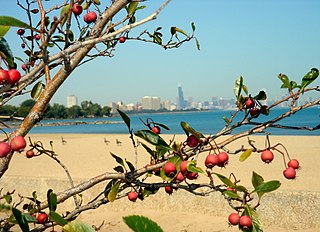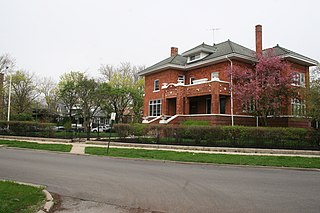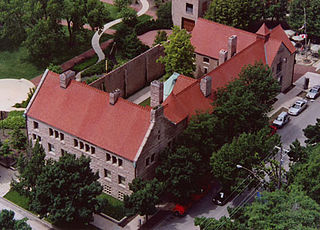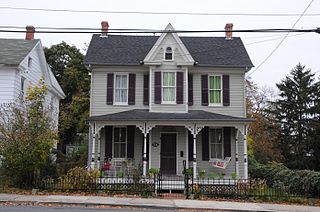
South Shore is one of 77 defined community areas of Chicago, Illinois, United States. A predominantly African-American neighborhood on the city's South Side, the area is named for its location along the city's southern lakefront. Although South Shore has seen a greater than 40% decrease in residents since Chicago's population peaked in the 1950s, the area remains one of the most densely populated neighborhoods on the South Side. The community benefits from its location along the waterfront, its accessibility to Lake Shore Drive, and its proximity to major institutions and attractions such as the University of Chicago, the Museum of Science and Industry, and Jackson Park.

The Near South Side is a community area of Chicago, Illinois, United States, just south of the downtown central business district, the Loop. The Near South Side's boundaries are as follows: North—Roosevelt Road ; South—26th Street; West—Chicago River between Roosevelt and 18th Street, Clark Street between 18th Street and Cermak Road, Federal between Cermak Road and the Stevenson Expressway just south of 25th Street, and Clark Street again between the Stevenson and 26th Street; and East—Lake Michigan.

Hyde Park is a neighborhood and historic district in Austin, Texas. Located in Central Austin, Hyde Park is defined by W. 38th Street to the south, W. 51st Street to the north, Duval Street to the east, and Guadalupe Street to the west. It is situated just north of the University of Texas and borders the neighborhoods of Hancock and North Loop.

The Kenwood Historic District is a U.S. historic district located in St. Petersburg, Florida. The district was designated on August 4, 2003 and is located immediately west of downtown, bounded by 9th Avenue North, 1st Avenue North, 19th Street North and 34th Street North. It contains 2,203 historic buildings, and Grand Central adjoins the district at its southern boundary.

The American System-Built Homes were modest houses designed by architect Frank Lloyd Wright. They were developed between 1912 and 1916 to fulfill his interest in affordable housing. Wright was devoted to the idea of providing beautiful yet affordable homes to the public. His firm produced over 960 drawings for the project, the largest number of drawings for any project in the Wright archives. The designs were standardized, and customers could choose from seven models. Because of this standardization, the lumber could be precut at the factory, thereby cutting down on both waste and the amount of skilled labor needed for construction. The buildings are often termed prefabricated homes, but they were not, since no parts of the homes were constructed off-site. The lumber was cut at the factory, packaged along with all other components, and delivered to the work site for construction. Some are located in a federal historic district in Milwaukee, Wisconsin, and others have been designated Chicago Landmarks in Chicago, Illinois.

The Drake Park Neighborhood Historic District is located adjacent to Drake Park near the historic downtown area in Bend, Oregon, United States. Because of the unique and varied architecture in the Drake Park neighborhood and its close association with the early development of the city of Bend, the area was listed on the National Register of Historic Places in 2005.

Highland Heights–Stevens' Subdivision Historic District is a residential historic district located in Highland Park, Michigan along five east-west streets: Farrand Park, McLean Street, Colorado Street, Rhode Island Street, and Massachusetts Street, between Woodward Avenue on the west and Oakland Avenue on the east. The district was listed on the National Register of Historic Places in 1988.

The Medbury's–Grove Lawn Subdivisions Historic District is a residential historic district located in Highland Park, Michigan. It runs along three east-west streets: Eason Street, Moss Street, and Putitan Street, from Hamilton Avenue on the west to Woodward Avenue on the east. The district was listed on the National Register of Historic Places in 1988.

Glenview Historic District is a neighborhood in Memphis, Tennessee that was listed on the National Register of Historic Places as a historic district in 1999. The neighborhood is between South Memphis and Midtown and bounded by the Illinois Central Railroad on the west, Lamar Ave on the east, Southern Ave on the north and South Parkway on the south.

The Ravenswood Manor Historic District is a historic district in the Albany Park community area of North Side, Chicago, Illinois. It is bordered by the Chicago River on the East, and by the alley south of Lawrence Avenue on the North, Sacramento Avenue on the West, and the alley North of Montrose Avenue on the south.

Prairie Avenue is a north–south street on the South Side of Chicago, which historically extended from 16th Street in the Near South Side community area of Chicago in Cook County, Illinois, United States, to the city's southern limits and beyond. The street has a rich history from its origins as a major trail for horseback riders and carriages. During the last three decades of the 19th century, a six-block section of the street served as the residence of many of Chicago's elite families and an additional four-block section was also known for grand homes. The upper six-block section includes part of the historic Prairie Avenue District, which was declared a Chicago Landmark and added to the National Register of Historic Places.

The Garden Homes Historic District is a residential historic district located in the Chatham neighborhood of the South Side, Chicago, Illinois. The district includes 152 residential buildings, 88 of which are contributing buildings, built in 1919-20 as Chicago's first large housing project. The newly formed Chicago Housing Association, a group of 22 prominent Chicago businessmen that included J. Ogden Armour, Charles H. Wacker, and William Wrigley, Jr., planned the homes as an affordable housing project for working-class Chicagoans. At the time, the city was suffering from a post-World War I housing crisis, and many of its working-class residents lived in tenements or other unlivable housing. Architect Charles Sumner Frost designed the homes, which were mainly brick cottages and stucco duplexes. The houses were built on unusually large lots for the time; the extra land was designed to serve as garden space for residents.

Martinsburg Mining, Manufacturing & Improvement Co. Historic District is a national historic district located at Martinsburg, Berkeley County, West Virginia. It encompasses 289 contributing buildings located within 19 city blocks and built between 1891 and 1952. It includes a residential area developed by the Martinsburg Mining, Manufacturing & Improvement Co. as worker housing. They are one to 2 1/2 story, single family, detached, semi-detached, and multi-unit housing built in wood frame, brick or brick veneer, and concrete block. Also located in the district is the Gothic Revival-style St. Luke's United Methodist Church. It includes examples of vernacular interpretations of popular architectural styles including Queen Anne, American Four Square, and Bungalow styles.

The West Line Historic District is a residential community in central Austin, Texas, United States. The district encompasses an approximately 90-block tract of land located west of downtown. Bounded by Baylor Street to the east, Fifth Street to the south, Thirteenth Street to the north and Texas State Highway Loop 1 to the west. It is located south of the Old West Austin Historic District and southeast of the Clarksville Historic District.

The Pilsen Historic District is a historic district located in the Pilsen neighborhood of Chicago. Pilsen is a neighborhood made up of the residential sections of the Lower West Side community area of Chicago. In the late 19th century Pilsen was inhabited by Czech immigrants who named the district after Plzeň, the fourth largest city in what is now the Czech Republic. The population also included in smaller numbers other ethnic groups from the Austro-Hungarian Empire including Slovaks, Slovenes, Croats and Austrians, as well as immigrants of Polish and Lithuanian heritage.

The Mayfair Apartments are a historic apartment hotel at 1650–1666 E. 56th Street in the Hyde Park neighborhood of Chicago, Illinois. Built in 1926, the building was part of a wave of residential department in Hyde Park, and it was one of several apartment hotels constructed there in the late 1910s and 1920s. Apartment hotels were popular among wealthy workers looking for part-time city housing, as they combined the amenities and prestige of a hotel with the price and location of apartments. The architecture firm Lowenberg & Lowenberg designed the building in the Georgian Revival style. The building's first three stories are clad with limestone and decorated with flat Corinthian columns and balustrades on the second-story windows. The remainder of the building is brick and includes a dentillated cornice at its roof and a second cornice above its eleventh story.

The South Park Manor Historic District is a residential historic district in the Greater Grand Crossing neighborhood of Chicago, Illinois. The district includes 263 Chicago bungalows built between 1915 and 1927. At the time, single-family homeownership was becoming broadly accessible to Chicagoans, and the bungalow was a popular choice for dense urban housing. The bungalows in the district were designed by several developers, but the district has a consistent appearance nonetheless. The use of a single home type throughout provided uniformity to the neighborhood, while stylistic variations such as the placement of dormers and porches gave each house its own character. The developers also gave their homes spacious lawns and private backyards to preserve green space in an urban setting.

The Walnut Street Historic District is a nationally recognized historic district located in Waterloo, Iowa, United States. It was listed on the National Register of Historic Places (NRHP) in 2019. At the time of its nomination the district consisted of 111 resources, including 91 contributing buildings and 20 non-contributing buildings. The district is largely a residential area located between the central business district and the former location of the Illinois Central Railroad round house and shops. The neighborhood was originally platted as the Railroad Addition in 1860 and as the Cooley Addition in 1865. Buildings date from c. 1880 to 1981. Single-family houses are largely wood-frame construction with a few brick. Architectural styles include Queen Anne, Italianate, Shingle, Bungalow, variations on the American Foursquare, and those in a vernacular mode. Multi-family dwellings include double houses, identical houses, and apartment buildings. There are also a few commercial buildings on East Fourth Street and two churches. Walnut Street Baptist Church (1908) is individually listed on the NRHP. Two local architects, Mortimer Cleveland and Clinton Shockley have buildings in the district.

The South Shore Bungalow Historic District is a residential historic district in the South Shore neighborhood of Chicago, Illinois. The district contains 229 Chicago bungalows and twenty other residential buildings built between 1911 and 1930. As homes became more accessible to families in early 20th century Chicago, thousands of bungalows were built to meet the housing demand. While bungalows were affordable mainly due to their uniform designs, their builders changed details such as color and entrance position to keep each home unique. The South Shore bungalows were among the first built in the city, as South Shore was already a popular neighborhood when the bungalow boom began, and the district contains many 1910s stucco bungalows; however, every bungalow built after 1917 is brick.

The Auburn Gresham Bungalow Historic District is a residential historic district in the Auburn Gresham neighborhood of Chicago, Illinois. The district includes 264 Chicago bungalows built from 1918 to 1932 along with a variety of other residential buildings. Homeownership became more attainable for working-class Chicagoans in the early twentieth century, and affordable bungalows played a key role in this pattern, with tens of thousands of the homes built in the city. Auburn Gresham, a South Side neighborhood with railroad access and little prior development, was one of the many parts of the city developed during the bungalow boom. While thirty-two different architects designed homes in the district, the bungalows are still relatively similar, as the uniform building design was a major factor in their affordability; however, elements such as color and brickwork distinguish the individual homes.



























